Design and Research of Laminated Packaging Structure for Semiconductor Laser Diode
Abstract
1. Introduction
2. Structure Design and Thermal Analysis
2.1. Structural Modeling
2.2. Heat Transfer
2.3. Thermal Design Analysis
2.4. Junction Temperature vs. Power
3. Experimental Verification
4. Conclusions
Author Contributions
Funding
Institutional Review Board Statement
Informed Consent Statement
Data Availability Statement
Conflicts of Interest
References
- Yan, Y.; Zheng, Y.; Sun, H.; Duan, J. Review of Issues and Solutions in High-Power Semiconductor Laser Packaging Technology. Front. Phys. 2021, 9, 669591. [Google Scholar] [CrossRef]
- Wandera, C.; Kujanpää, V.; Salminen, A. Laser power requirement for cutting thick-section steel and effects of processing parameters on mild steel cut quality. Proc. Inst. Mech. Eng. Part B J. Eng. Manuf. 2011, 225, 651–661. [Google Scholar] [CrossRef]
- Bachmann, F. Goals and Status of the German National Research Initiative. Proc. SPIE 2007, 6456, 1–12. [Google Scholar]
- Nozaki, S.; Yoshida, S.; Yamanaka, K.; Imafuji, O.; Takigawa, S.; Katayama, T.; Tanaka, T. High-power and high-temperature operation of an InGaN laser over 3 W at 85 °C using a novel double-heat-flow packaging technology. Jpn. J. Appl. Phys. 2016, 55, 04EH05. [Google Scholar] [CrossRef]
- Zhang, X.; Bo, B.; Qiao, Z.; Xu, Y.; Gao, X. Analysis of thermal characteristics based on a new type diode laser packaging structure. Opt. Eng. 2017, 56, 085105. [Google Scholar] [CrossRef]
- Wang, Y.; Qu, H.; Zheng, W. Study on New Type of Double-Sided Cooling Packaging Technology for Semiconductor Lasers. IOP Conf. Ser. Earth Environ. Sci. 2021, 769, 042003. [Google Scholar] [CrossRef]
- Ni, Y.; Jing, H.; Kong, J.; Wang, C.; Liu, S.; Ma, X. Thermal Performance of High-Power Laser Diodes Packaged by SiC Ceramic Submount. Chin. J. Lasers 2018, 45, 0101002. [Google Scholar] [CrossRef]
- Faircloth, B.O. High-brightness high-power fiber coupled diode laser system for material processing and laser pumping. Proc. SPIE 2003, 4973, 34–41. [Google Scholar]
- England, P.C.; Bruce, T.A. Pressure—Temperature—Time Paths of Regional Metamorphism I. Heat Transfer during the Evolution of Regions of Thickened Continental Crust. J. Petrol. 1984, 25, 894–928. [Google Scholar] [CrossRef]
- Sadeghipour, M.S.; Manzari, M. Finite element solution of the non-Fourier heat conduction equation. HTD - Am. Soc. Mech. Eng. Heat Transf. Div. 1990, 130, 141–148. [Google Scholar]
- Wang, B.L.; Han, J.C. A finite element method for non-Fourier heat conduction in strong thermal shock environments. Front. Mater. Sci. China 2010, 4, 226–233. [Google Scholar] [CrossRef]
- Wang, J.; Shi, L.; Li, Y.; Jin, L.; Xu, Y.; Zhang, H.; Zou, Y.; Lan, Y.; Ma, X. Thermal management of graphene-induced high-power semiconductor laser package with bidirectional conduction structure. Opt. Laser Technol. 2021, 139, 106927. [Google Scholar] [CrossRef]
- Liu, X.; Zhao, W.; Xiong, L.; Liu, H. Packaging of High-Power Semiconductor Lasers; Springer: New York, NY, USA, 2015. [Google Scholar]
- Liu, V.X. Technology Trend and Challenges in High Power Semiconductor Laser Packaging. In Proceedings of the 2010 IEEE Electronic Components & Technology Conference, Las Vegas, NV, USA, 1–4 June 2010. [Google Scholar]
- Ma, Z.; Lin, T.; Zhao, R.; Sun, W.; Mu, Y.; Li, Y.; Xie, J. Research on Thermal Analysis Modeling of Semiconductor Laser Based on Package Prototype. Laser Optoelectron. Prog. 2021, 58, 9. [Google Scholar]
- Lorenzen, D.; Hennig, P. Highly Thermally Conductive Substrates with Adjustable CTE for Diode Laser Bar Packaging; International Society for Optics and Photonics: Bellingham, WA, USA, 2003. [Google Scholar]
- Wu, D.H.; Zah, C.E.; Liu, X. Three-dimensional thermal model of a high-power diode laser bar. Appl. Opt. 2018, 57, 9868–9876. [Google Scholar] [CrossRef] [PubMed]
- Vermeersch, B.; Mey, G.D. Influence of substrate thickness on thermal impedance of microelectronic structures. Microelectron. Reliab. 2007, 47, 437–443. [Google Scholar] [CrossRef][Green Version]
- Coldren, L.A.; Corzine, S.W.; Mashanovitch, M.L. Diode Lasers and Photonic Integrated Circuits. Opt. Eng. 1997, 55–60. [Google Scholar] [CrossRef]
- Bacchin, G.; Fily, A.; Qiu, B.; Fraser, D.; Robertson, S.; Loyo-Maldonado, V.; McDougall, S.D.; Schmidt, B. High temperature and high peak-power 808 nm QCW bars and stacks. Proc. SPIE 2010, 7583, 75830P. [Google Scholar]
- Zhu, N. Microwave Design and Characterization of Optoelectronic Devices and Packaging; Chinese Science Publishing & Media Ltd.: Beijing, China, 2007. (In Chinese) [Google Scholar]
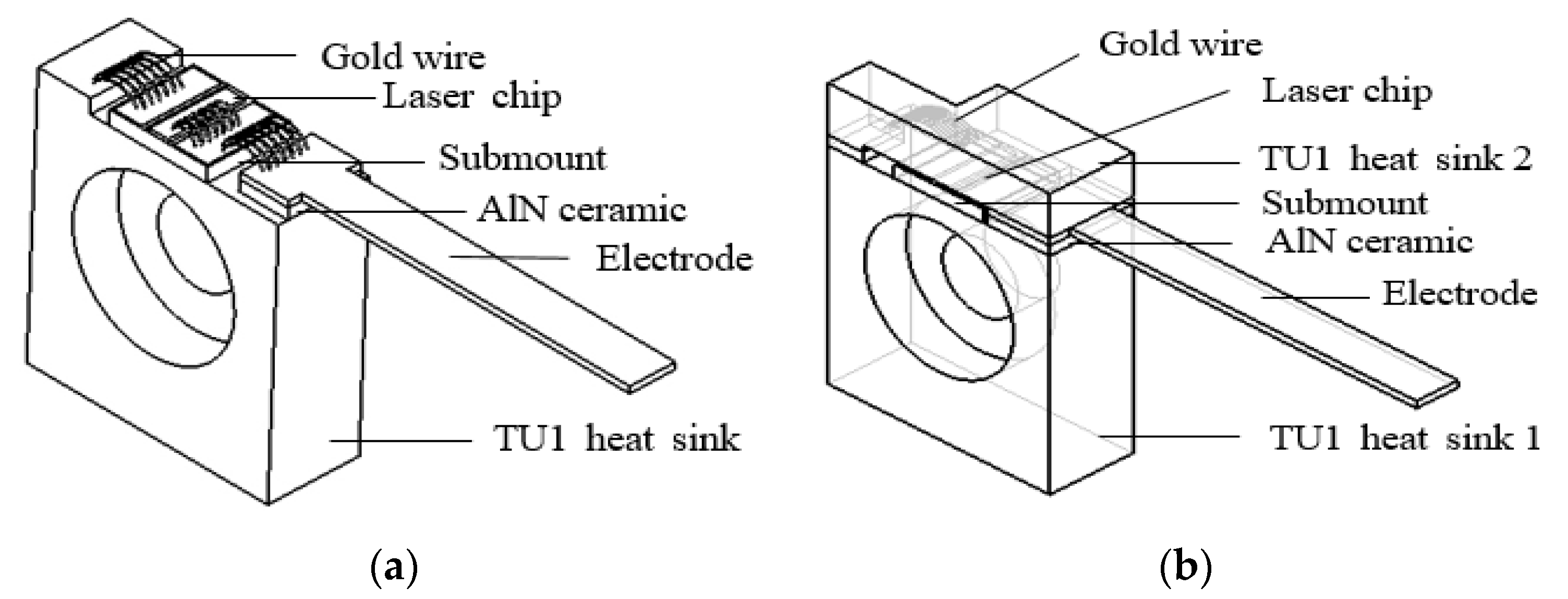
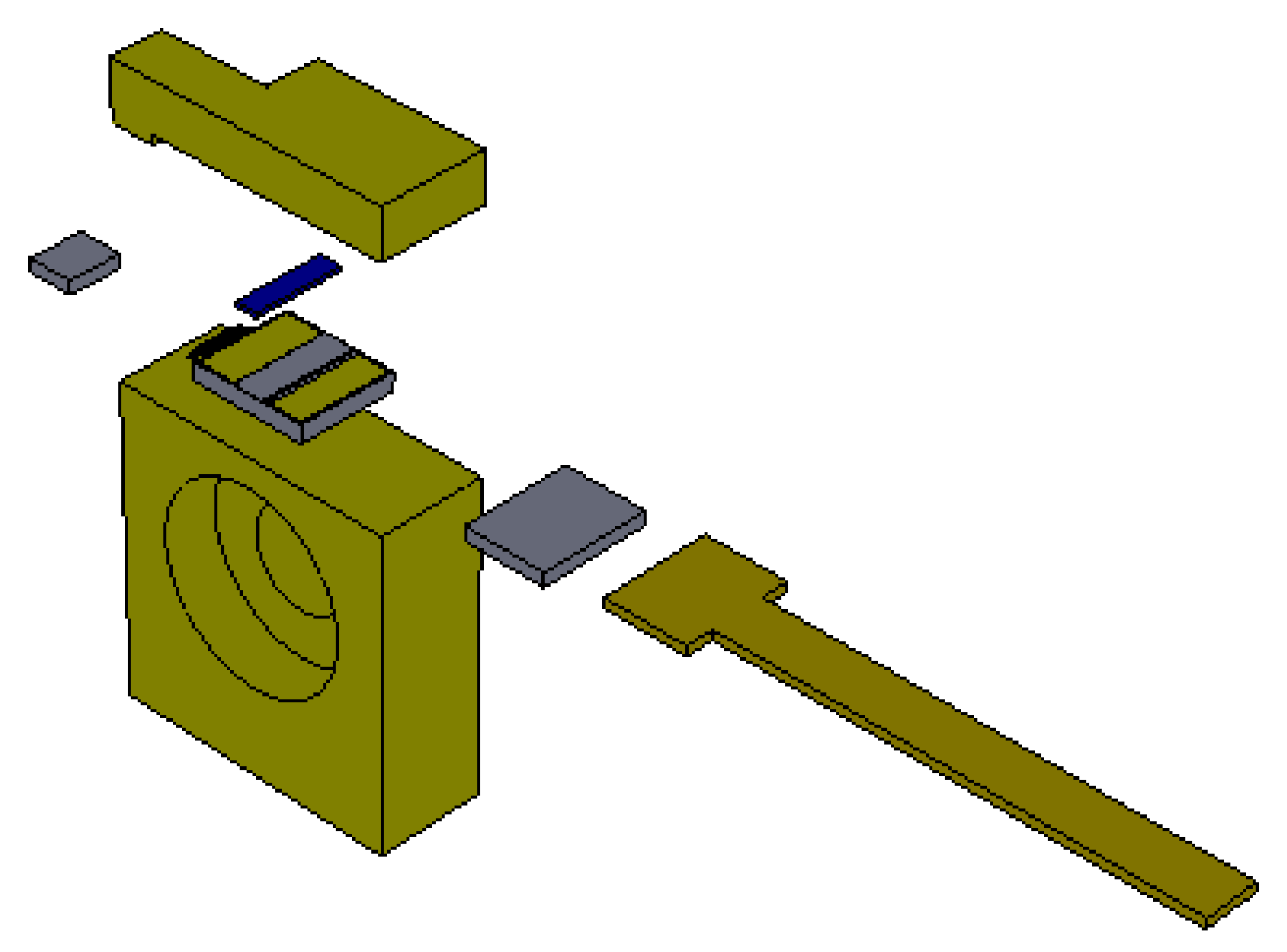
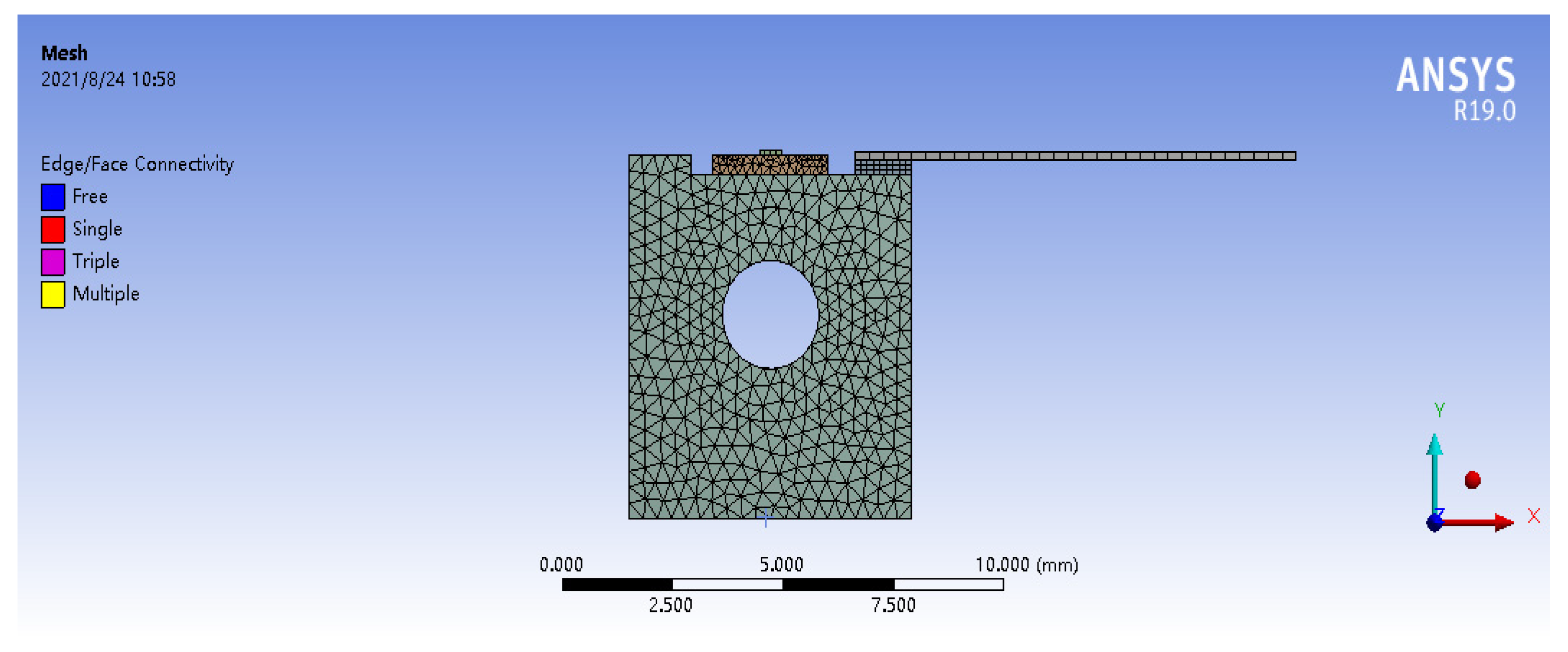
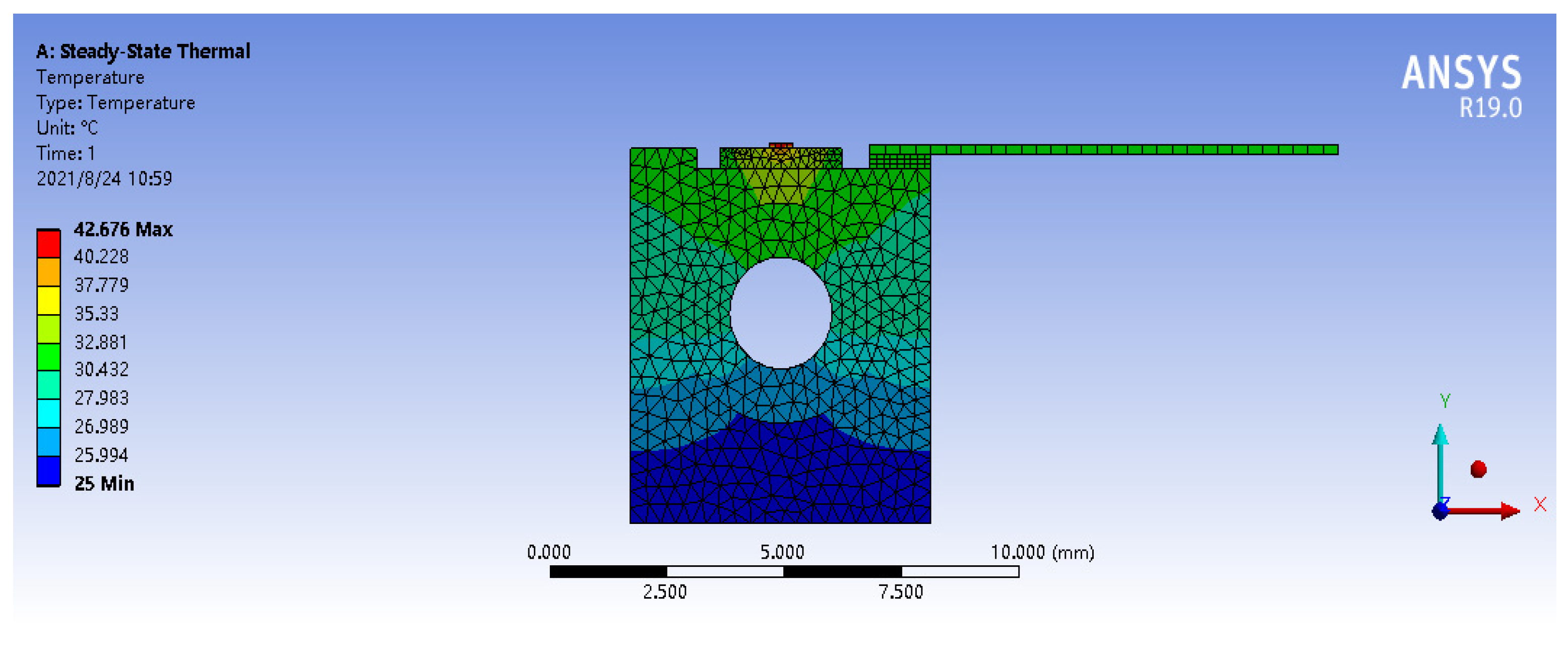




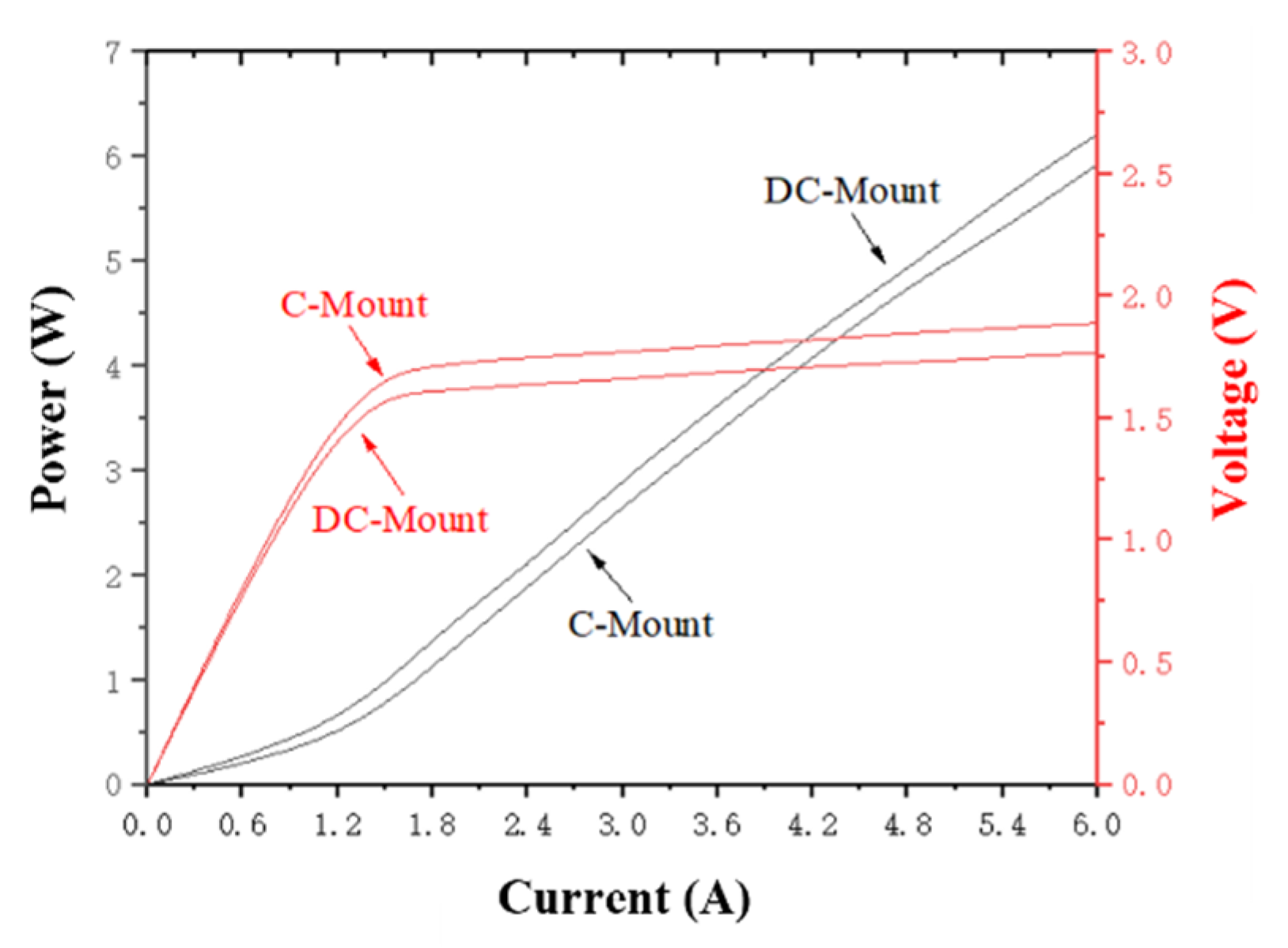
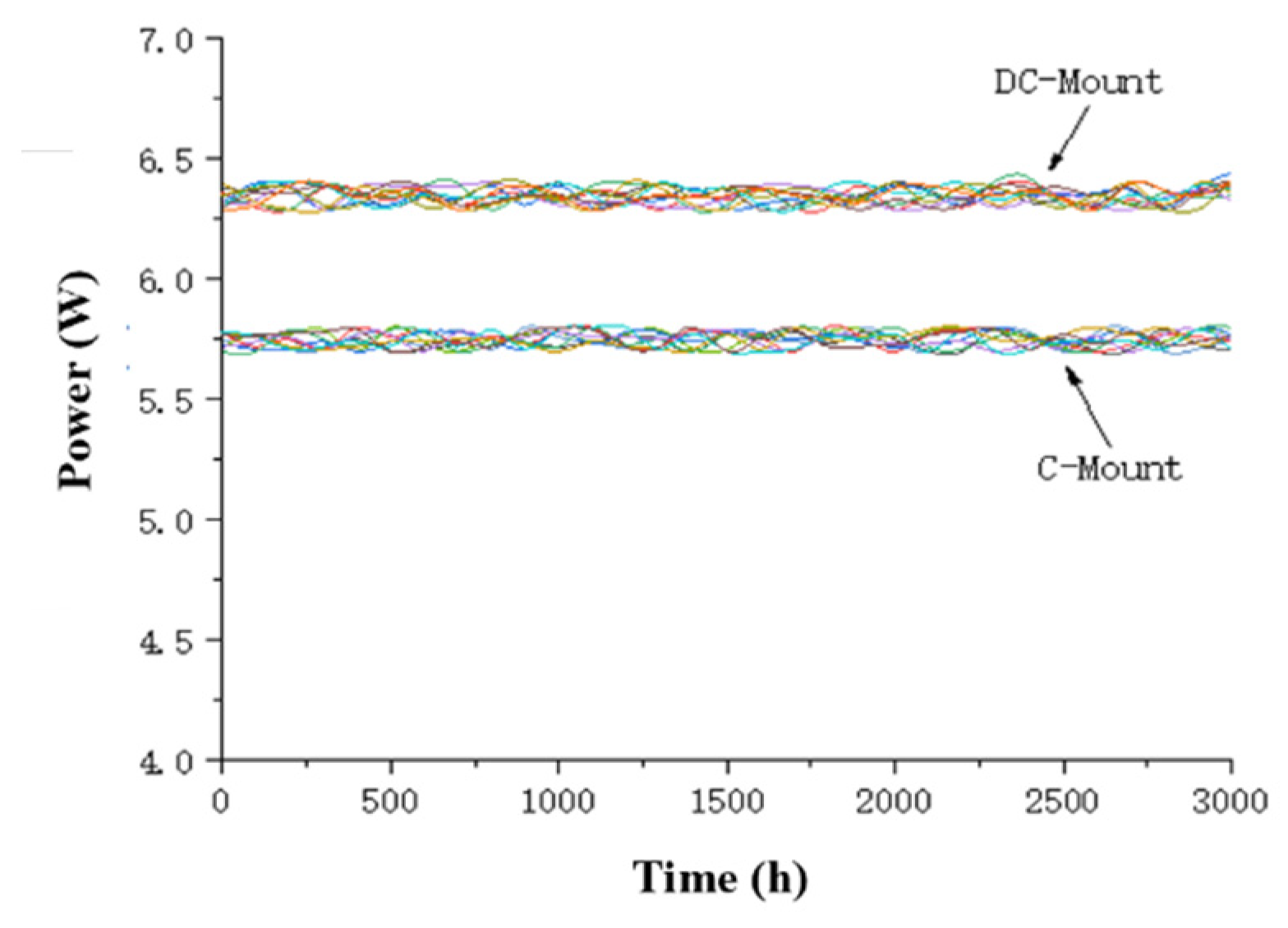
| Structure | Material | Size (L × W × H) (mm) | Thermal Conductivity [W/(m·°C)] |
|---|---|---|---|
| Laser chip | GaAs | 2 × 0.5 × 0.12 | 55 |
| AuSn film | AuSn | 2 × 0.5 × 0.01 | 57.3 |
| In film | In | 2.6 × 2.2 × 0.05 | 83.7 |
| Submount | AlN | 2.6 × 2.2 × 0.4 | 180 |
| Heat sink 1 | TU1 | 6.4 × 2.4 × 7.3 | 398 |
| Heat sink 2 | TU1 | 6.4 × 2.4 × - | 398 |
Publisher’s Note: MDPI stays neutral with regard to jurisdictional claims in published maps and institutional affiliations. |
© 2022 by the authors. Licensee MDPI, Basel, Switzerland. This article is an open access article distributed under the terms and conditions of the Creative Commons Attribution (CC BY) license (https://creativecommons.org/licenses/by/4.0/).
Share and Cite
Xu, P.; Wang, B.; Qian, Y.; Wang, Y.; Teng, Y.; Wang, X. Design and Research of Laminated Packaging Structure for Semiconductor Laser Diode. Coatings 2022, 12, 1450. https://doi.org/10.3390/coatings12101450
Xu P, Wang B, Qian Y, Wang Y, Teng Y, Wang X. Design and Research of Laminated Packaging Structure for Semiconductor Laser Diode. Coatings. 2022; 12(10):1450. https://doi.org/10.3390/coatings12101450
Chicago/Turabian StyleXu, Peidong, Bin Wang, Yang Qian, Yong Wang, Yunjie Teng, and Xiantao Wang. 2022. "Design and Research of Laminated Packaging Structure for Semiconductor Laser Diode" Coatings 12, no. 10: 1450. https://doi.org/10.3390/coatings12101450
APA StyleXu, P., Wang, B., Qian, Y., Wang, Y., Teng, Y., & Wang, X. (2022). Design and Research of Laminated Packaging Structure for Semiconductor Laser Diode. Coatings, 12(10), 1450. https://doi.org/10.3390/coatings12101450






